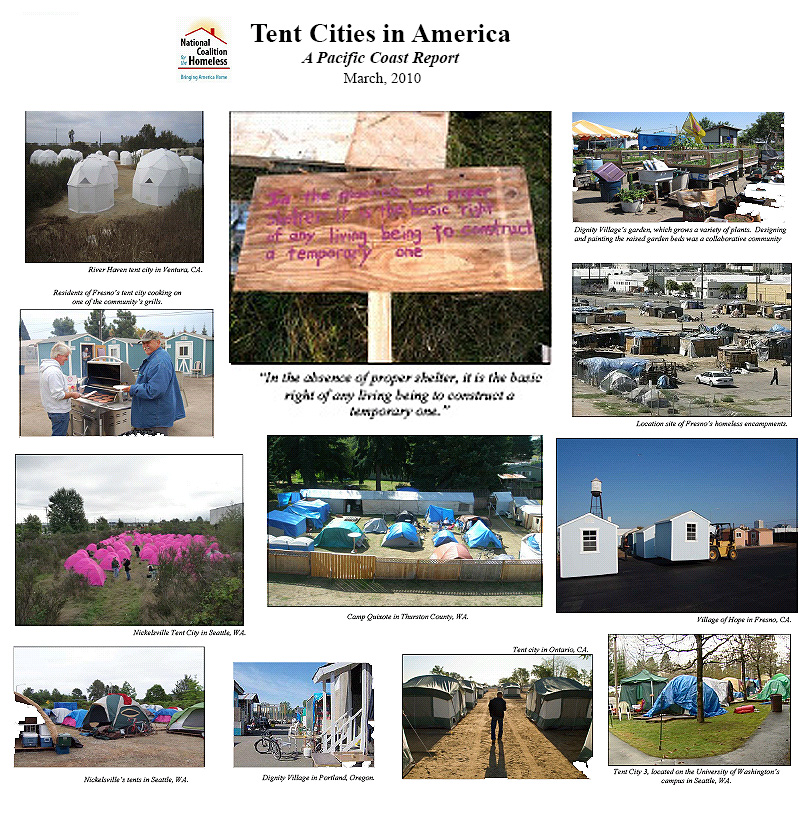Education News:
Economic
Crisis Devastates Rich & Poor - Tent Cities
in America
---------------------------------------------------
19 March 2010: Updated 15 October 2011
Contact: Stephen M.
Apatow
Founder,
Director of Research & Development
Humanitarian
Resource Institute
Humanitarian University
Consortium Graduate Studies
Center
for Medicine, Veterinary Medicine & Law
Phone:
203-668-0282
Email:
s.m.apatow@humanitarian.net
Internet:
www.humanitarian.net
Founder, United
Nations Arts Initiative
Arts Integration Into Education
Url: www.unarts.org
Twitter: unarts
Economic Crisis Devastates Rich & Poor - Tent
Cities
in America
Despite claims of a recovery, states and municipalities remain in
a
state of economic emergency, that began with the collapse of the
housing
market in 2007. Larry Summers, White House Chief Economic Advisor
describes
the current landscape as a "Statistical Recovery and Human Recession."
[1]
Normally the poor and impoverished represent the most severely impacted
populations in a recession, but today's economic emergency has also
devastated
middle and upper class Americans:
- Two
market
crashes: 2001-2002 and 2008, with severe damage to life savings and
retirement
accounts. [2]
- The
elimination
of regulatory oversight on the merged commercial/investment banking
industry
facilitated widespread predatory lending, mortgage and appraisal fraud.
To
date, upwards of 6 million victims have lost their homes to
foreclosure,
[3] with 7-9 million additional mortgages in the pipeline, eligible for
modification, according to the HopeNow Program. [4]
- 17.3%
real unemployment/underemployment [5] is not expected to stabilize
until
2015, [6] the projected time for recovery of the US housing
market. [7]
- Small
businesses and the self employed continue to struggle without
assistance
or economic relief. While the U.S. unemployment rate finally
dipped below
10 percent in January, construction industry unemployment actually
jumped
to 25 percent (The Toolbelt Recession). [8]
The
current
economic landscape has been compared to an economic Katrina, without a
disaster
declaration. The Humanitarian Resource Institute "UNArts National
Service
Initiative" is advancing a national campaign that targets unmet needs
analysis
on the household, small business, nonprofit and corporate level in
every
U.S. city. Unmet needs reports, strategic planning and relief
assistance
is the priority for the duration of this economic emergency.
The "UNArts National Service Initiative" provides a unique opportunity
for members of the arts and entertainment industry to serve as
facilitators
on the grassroots level. Community meetings, press conferences,
concerts
and performances provide a platform for the executive directors of
frontline service programs, to "Bridge Unmet Needs to Untapped
Resources." The
campaign is being led by Stephen Michael Apatow, [9] founder of
Humanitarian
Resource Institute and the United Nations Arts Initiative who is also
an
artist/publisher in the American Society of Composers, Authors and
Publishers
(ASCAP) and artist member of the Country Music Association.
On The Front Line
Click
here for a demographic needs overview by Zip Code. Includes:
Statistical Brief, Food insecurity rate, Child food
insecurity rate, Population, Poverty rate, Child poverty rate,
Unemployment
rate and listing for food banks.

Tent Cities in America: A Pacific Coast Report
National Coalition for the Homeless [10]
American’s Great Depression was greatly defined by the newly homeless
and their creation of tent cities. As the homeless gathered in shanty
towns they began calling them Hooverville’s, after the sitting
president, Herbert Hoover. Unemployment grew, rural communities
collapsed, industrial cities were economically shaken and both small
and large businesses failed, as millions more Americans became homeless
for the first time.
Currently, the United States is experiencing the worst economic crisis
since the Great Depression and its associated social ills are similar.
Americans are once again experiencing a significant growth in poverty
and double digit increases in their newly homeless. Just as during the
Great Depression, temporary housing has begun to dot the national
landscape, from coast to coast. Tent cities can now be found across the
United States, ranging from large organized communities to makeshift
encampments. This is not to say that tent cities have not remained on
America’s landscape since the 1930s, but due to the current
recession, there has been a rise in homelessness, and tent cities have
received
more media attention.
Since the Great Depression, Americans have tried unsuccessfully to cure
the social ill of modern homelessness by treating its symptoms rather
than
its causes. A severe lack of affordable housing and a scarceness of
jobs
that pay a living wage are the root causes of homelessness. But,
failing
a final solution-based strategy to ending homelessness, we are now
assigning
rank-and-resources within a hierarchy of needs and conditions, measured
along
a compassion scale of those who are deserving, less deserving and
undeserving.
Los Angeles estimates that 1,534 people live in homeless encampments.
Sacramento estimates that roughly 900 single adults and 100 families
are living in tent cities. Nashville and Des Moines each has
approximately 200-250 people living in tent cities. Providence has one
tent city with roughly 30 single adults. Seattle has one
city-sanctioned tent city with 100 beds. [11]
Regarding the size and scope of the homelessness in the United States:
Homeless Veterans: The National Coalition for the Homless estimates
that 150,000 veterans are homeless on any night and 600,000 will
experience homelessness during the course of the year. [12] The
VA estimates that 131,000
veterans are homeless on any given night. And approximately twice
that
many experience homelessness over the course of a year.
Conservatively,
one out of every three homeless men who is sleeping in a doorway,
alley or box in our cities and rural communities has put on a uniform
and
served this country. The vast majority are single, most come from
poor,
disadvantaged communities, 45 percent suffer from mental illness,
and
half have substance abuse problems. America’s homeless veterans have
served
in World War II, Korean War, Cold War, Vietnam War, Grenada, Panama,
Lebanon,
Operation Enduring Freedom (Afghanistan), Operation Iraqi Freedom, or
the
military's anti-drug cultivation efforts in South America.
47 percent
of homeless veterans served during the Vietnam Era. [13,14]
1.35 Million children are homeless during the year, 200,000 on any
given day. [12]
Between 1.6 and 2.8 million youth run away in a year. [15] Many
of
these children are lured into prostitution. [16] Runaway, thrownaway
and other homeless American children who use 'survival sex' to acquire
food, shelter, clothing and other things needed to survive on America's
streets.
[17]
The National Coalition for the Homeless believes that now is the time
that we, as a country, must embark on a final campaign to Bring America
Home
and end homelessness once and for all; through a coordinated and
comprehensive national response that addresses the housing, income,
healthcare, civil
rights, and causal factors and consequences of extreme poverty.
Organizations in The Spotlight
- FeedingAmerica.org:
Formerly known as the Second Harvest Foodbank Network. Access to Food
Banks and Statistical information can be accessed by zip code or state.
- HungerActionCenter.org:
Advocacy support.
- NationalHomeless.org: National Coalition
for the
Homeless.
- ConsumerLaw.org:
National
Consumer law Center.
Inspiration, Healing & Recovery
United Nations Arts Initiative
Url: www.unarts.org

References:
1. Summers: ‘Statistical Recovery and Human Recession’- Davos Live -
Wall Street Journal. Url: http://blogs.wsj.com/davos/2010/01/30/summers-statistical-recovery-and-human-recession/tab/article/
2. Bogle/Stiglitz: Economic Crisis Dialogue: Humanitarian
Resource
Institute, 5 March 2010. AIIE: "The Eagle Will Rise,"
Harvard Law Record. Url: http://www.unarts.org/news/aiie_ecd352010.html
3. Yes, Regulators Can Stop Foreclosures: The Nation, 10 December 2009.
Url: http://www.thenation.com/doc/20091221/kaufmann
4. HopeNow: Url: https://www.hopenow.com
5. Broader U-6 Unemployment Rate Increases to 17.3% in December, Wall
Street Journal Blog. 8 January 2010. Url: http://blogs.wsj.com/economics/2010/01/08/broader-u-6-unemployment-rate-increases-to-173-in-december/
6. Obama Advisers Predict High Unemployment, Low Growth for Next Five
Years: Daily Finance. 12 February 2010. Url: http://www.dailyfinance.com/story/obamas-economic-advisers-high-unemployment-moderate-growth-fo/19356653/
7. Latest Housing Recovery Prediction: 2015: Wall Street Journal, 13
May 2009. Url: http://blogs.wsj.com/developments/2009/05/13/latest-housing-recovery-prediction-2015/tab/article/
8. Taking on the Tool Belt Recession: Center for American Progress. 3
March 2010. Url: http://www.americanprogress.org/issues/2010/03/tool_belt_recession.html
9. Stephen Michael Apatow: Founder: Humanitarian Resource Institute,
United Nations Arts Initiative, Pathobiologics International. Url: http://www.apatow.org
10. Tent Cities in America: A Pacific Coast Report: National Coalition
for the Homeless. Url: http://nationalhomeless.org/publications/Tent%20Cities%20Report%20FINAL%203-10-10.pdf
11. U.S.
Conference
of Mayors 2009 Status Report on Hunger & Homelessness: Url: http://usmayors.org/pressreleases/uploads/USCMHungercompleteWEB2009.pdf
12. National Coalition for the Homless: Url: http://www.nationalhomeless.org/
13. National Coalition for Homeless Veterans: Url: http://www.nchv.org/
14. National Community Support for Armed Forces and Wounded Warrior
Project: Humanitarian Resource Institute, 27 July 2009. Url: http://www.unarts.org/news/woundedwarriors_7272009.html
15. National Runaway Swithboard: Url: http://www.nrscrisisline.org/
16. Running in the Shadows: A two-part article and video series in the
New York Times on the growing number of young runaways in the United
States. Url: http://www.1800runaway.org/media/nrs_in_news.html#NYTimesOct2009
17. Commercial Child Sexual Exploitation: "The Most Hidden Form of
Child Abuse," Says NASW Member Richard Estes: National Association of
Social Workers. Url: http://www.naswdc.org/pressroom/2001/091001.asp
###
|